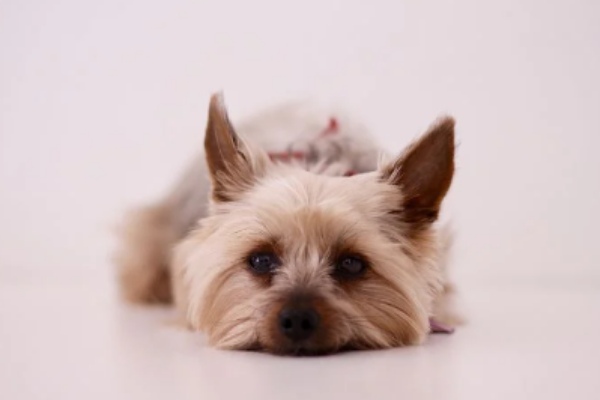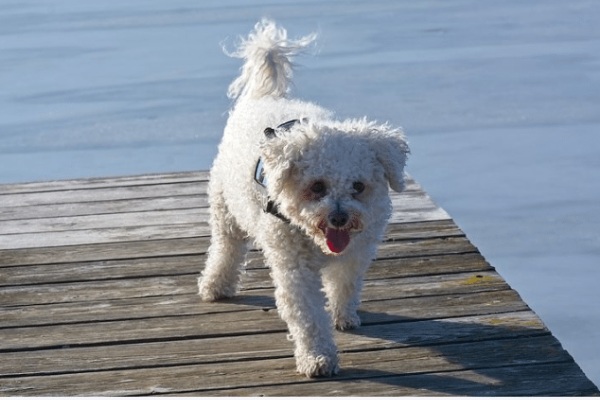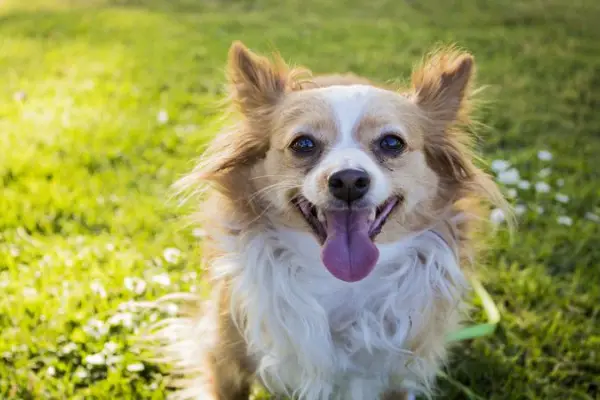11 Most Common Symptoms Of Anxiety In Dogs

Dogs show anxiety in different ways, so what are the symptoms of anxiety in dogs? Join me let’s find out together!
Most dogs have anxiety without their owners knowing, you can only find out when you pay close attention to dog anxiety signs.
What are these anxiety symptoms in dogs, that is exactly what I will be highlighting in this post!
With all my years of experience living with dogs, I will do my best to keep things simple.
A dog that has anxiety will show a combination of these signs.
Symptoms Of Anxiety In Dogs
The following are some typical and common symptoms of anxiety in dogs:
1. Frequently whining
One of the most prevalent indications of anxiousness in dogs is frequent whining or whimpering, which you should constantly be on the lookout for.
Anxious dogs whine or whimper to convey their feelings, just like a kid can weep when put into a situation that makes them exceedingly frightened.
If yes then check out other symptoms of anxiety in dogs on our list.
Does your dog whine when he goes outside, sees people, or other pets, or when you are about to leave home?
2. Frequent self-isolation
Most dogs’ self-isolation is triggered by a range of factors, the most common of which are anxiety and fear.
When a dog is terrified or nervous, he may seek refuge in a little chamber or a piece of the owner’s clothes that has his scent.
Your dog may urinate inconveniently for hours while curled up beneath the table or elsewhere in the house if he’s suffering from anxiety.
Don’t dismiss your dog’s constant hiding; instead, attempt to figure out why; it might be a health issue or nervousness.
In most dogs, this is one of the most evident indicators of anxiety and shouldn’t be ignored.
3. Frequent freezing
Your dog freezes or gets rigid when you return home from work or leave because he is terrified of being alone, which might create anxiety.
Frequent freezing in dogs can be dangerous to both you and your dog since it can lead to biting and other behavioral problems.
If your dog stops as you walk away, he’s worried and won’t be able to deal with the situation, which might lead to a bite.
Dogs with anxiety are known to freeze unnecessarily when their owners leave or return, which is a clear symptom of nervousness.
4. Increased barking behavior
Because of fear, frustration, stress, tension, and loneliness, most dogs with anxiety will bark incessantly, which can be an issue for both you and your neighbors.
In some dogs, anxiety builds over time and manifests within minutes of being aroused.
Dogs with anxiety may bark excessively when their owners go to work or somewhere else because they are afraid of being alone.
As a result, you should be worried if your dog begins to bark significantly more than usual when you leave or enter.
If your dog starts barking or howling every time you leave the house, look for additional indicators of anxiety in dogs.
5. Frequent destructive chewing
When dogs are removed from their owners, their things or toys may be scratched, chewed, or destroyed.
Your dog may have chewed the table legs, doors, window sills, and door frames, and even damaged the couch or cushions when you return home.
The most prevalent reasons for dangerous chewing are depression, stress, and loneliness, all of which can be triggered by anxiety and fear.
Chewing and digging in your house can lead to injuries such as broken teeth, scrapes, nail or paw damage, and even harm from broken furniture.
6. Pacing on owner’s departure
Frequent excessive pacing on the owner’s departure or owner’s arrival can be one of the symptoms of anxiety in dogs.
When your dog starts pacing back and forth as you leave the house, it means something is disturbing them and they are unable to relax, which might indicate nervousness.
If your dog paces back and forth during mealtimes or for brief periods when you’re out on a walk, it may not be a huge worry.
If you see this behavior on a regular basis, especially when you’re leaving or returning home, you might be able to figure out what’s scaring your dog.
7. Excessive licking and panting
Dogs lick for a variety of reasons, but excessive licking typically indicates that there is a problem such as anxiety.
Licking causes endorphins to be released in the dog’s brain, which reduces anxiety and makes them feel better.
You may have an anxious dog if you observe your dog licking a lot, especially if it is licking hard. It’s the same if it licks or chews its feet or legs.
Panting is another indicator of tension or worry, especially when it isn’t hot outside.
When a dog is wounded or sick, as well as when they are terrified, they will pant. “Stress panting” is the term for this type of panting.
8. Frequent potty accidents when left alone
If your dog has been trained to be housebroken but still has accidents when you leave the house and return to find them.
This is a clear indication that your dog is worried about you while you’re gone, and if the problem isn’t handled, it will only become worse.
If your puppy or adult dog becomes fearful and begins to eat his or her own feces, keep an eye on him or her.
You can try to avoid this symptom or just cure the underlying cause of your dog’s anxiety, no matter how unpleasant it is.
9. Frequent digging
Anxiety is one of the most common reasons your dog digs up your yard, fence posts, bed, or basement.
When they are bored or have nothing else to do, they dig to keep themselves occupied and away from boredom or loneliness.
If your dog is digging in your yard, cellar, bed, or fence base when you get home, you must interfere and try to calm him down.
That’s a clear indicator that your dog is bored, and ignoring it will only make things worse.
10. Destructive behaviors
When a dog’s worry becomes panic, it can lead to destructive behavior.
If a dog feels imprisoned, they will try all they can to get out, which can result in clawed wallboards, chewed trim and doors, shattered windows and screens, and even catastrophic injuries.
When dogs are left alone, they may exhibit a variety of escape behaviors in an attempt to reconnect with their owners.
Dogs that haven’t been properly crate trained may feel imprisoned inside their cages, which can make them anxious.
Chewing on the crate is a frequent way for dogs to get out, but it can damage their jaws and break their teeth.
Choking dangers might be created if they rip up their bedding or toys.
11. Increased aggressive behavior
Aggression between dogs and their owners is a significant problem that can result in harm and can be triggered by anxiety or stress.
Aggression has a variety of origins and can be caused by a variety of events.
Anxiety, fear, territorial impulses, pain, dominance, and possessiveness are all common triggers of dog aggressive behaviors.
Recognize the causes of your dog’s aggression and then handle the behavior in a way that helps them move over their triggers.
One of the most prevalent tendencies in dogs is aggression.
It’s also the primary reason why veterinarians and pet owners should seek the advice of experienced behaviorists and trainers.
There are other reasons why your dog can become aggressive towards other dogs.
Related Questions
How can I tell if my dog is experiencing anxiety?
You might notice your dog showing signs like excessive panting, pacing, whimpering, or seeking excessive reassurance from you. They might also display destructive behavior, excessive barking, or even loss of appetite. Keep an eye out for any changes in their behavior or habits.
What are some common triggers for anxiety in dogs?
Dogs can be triggered by various factors, such as separation from their owners, loud noises like thunderstorms or fireworks, changes in routine, or even meeting new people or animals. Understanding your dog’s triggers can help you manage their anxiety better.
Learn more about dog anxiety causes.
Can anxiety in dogs be treated?
Yes, anxiety in dogs can be managed and treated. There are various approaches, including behavior modification, training, and in some cases, medication. It’s important to work with a veterinarian or a professional dog behaviorist to develop a suitable treatment plan for your furry friend.
How can I help my dog feel more comfortable during anxious episodes?
Creating a safe space for your dog, using calming aids like pheromone diffusers or calming music, and providing plenty of physical and mental stimulation can help ease their anxiety. Additionally, maintaining a consistent routine can provide a sense of security for your dog.
Can anxiety in dogs affect their physical health?
Yes, prolonged anxiety in dogs can have physical effects, such as digestive issues, skin problems, and even a weakened immune system. This is why it’s important to address anxiety in dogs and provide them with the support they need.
When should I seek professional help for my dog’s anxiety?
If you notice that your dog’s anxiety is significantly impacting their quality of life or if their symptoms are worsening despite your efforts, it’s best to consult a veterinarian or a certified dog behaviorist. They can help assess the situation and recommend the most suitable treatment for your dog.
Conclusion
In conclusion, recognizing the symptoms of anxiety in our furry companions is crucial for their well-being. By paying attention to signs like excessive barking, pacing, or destructive behavior, we can take proactive steps to help our dogs feel more secure and relaxed. Remember, a little extra love and support can go a long way in easing their anxiety and enriching their lives.






